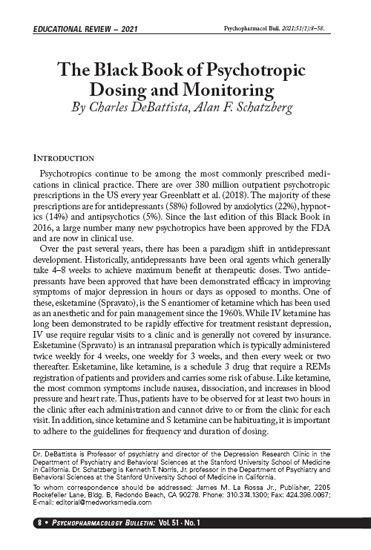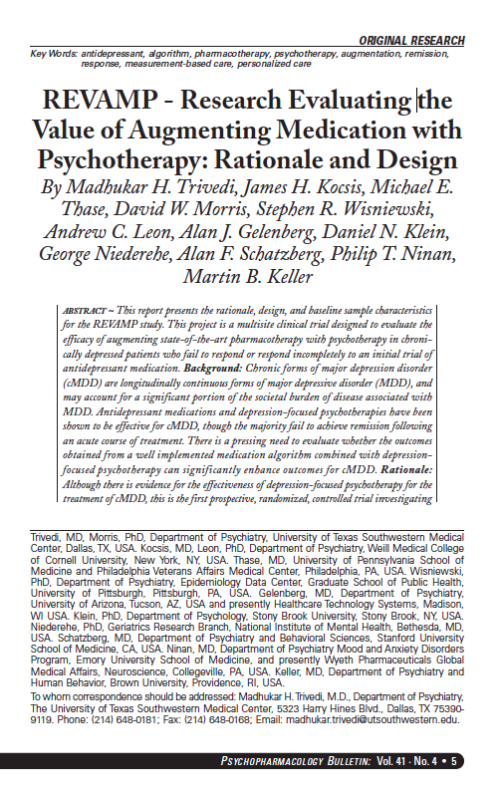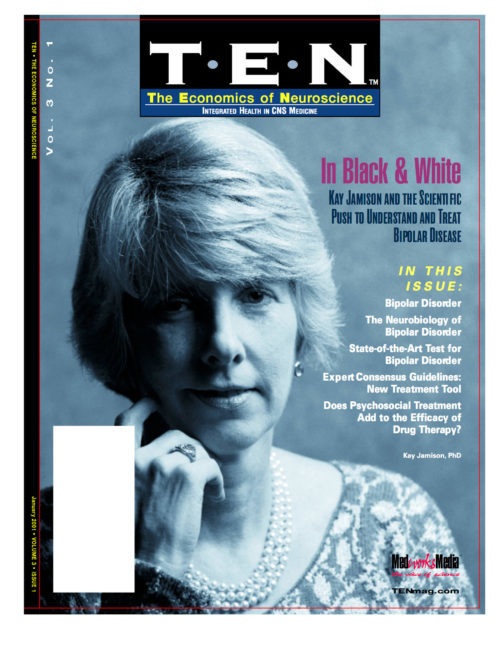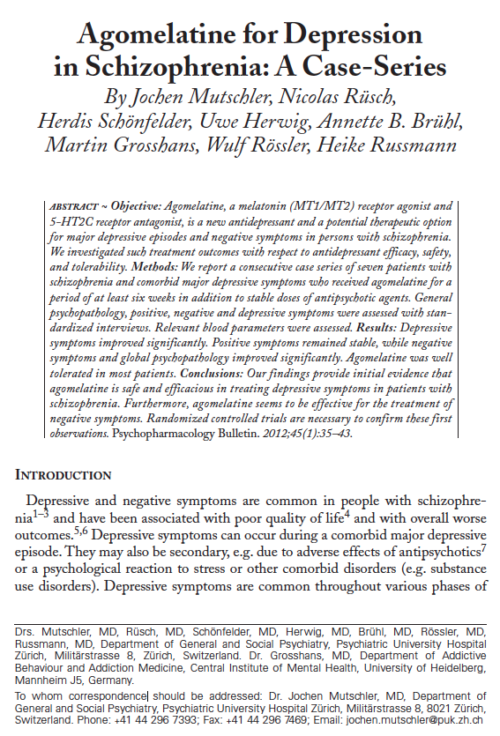Description
Educational Review – 2021
The Black Book of Psychotropic Dosing and Monitoring
By Charles DeBattista, Alan F. Schatzberg
Psychotropics continue to be among the most commonly prescribed medications in clinical practice. There are over 380 million outpatient psychotropic prescriptions in the US every year Greenblatt et al. (2018). The majority of these prescriptions are for antidepressants (58%) followed by anxiolytics (22%), hypnotics (14%) and antipsychotics (5%). Since the last edition of this Black Book in 2016, a large number many new psychotropics have been approved by the FDA and are now in clinical use.
Over the past several years, there has been a paradigm shift in antidepressant development. Historically, antide- pressants have been oral agents which generally take 4–8 weeks to achieve maximum benefit at therapeutic doses. Two antidepressants have been approved that have been demonstrated efficacy in improving symptoms of major depression in hours or days as opposed to months. One of these, esketamine (Spravato), is the S enantiomer of ket- amine which has been used as an anesthetic and for pain management since the 1960’s. While IV ketamine has long been demonstrated to be rapidly effective for treat- ment resistant depression, IV use require regular visits to a clinic and is generally not covered by insurance. Esketamine (Spravato) is an intranasal preparation which is typically administered twice weekly for 4 weeks, one weekly for 3 weeks, and then every week or two thereafter. Esketamine, like ketamine, is a schedule 3 drug that require a REMs registration of patients and providers and carries some risk of abuse. Like ketamine, the most common symptoms include nausea, dissociation, and increases in blood pres- sure and heart rate. Thus, patients have to be observed for at least two hours in the clinic after each administration and cannot drive to or from the clinic for each visit. In addi- tion, since ketamine and S ketamine can be habituating, it is important to adhere to the guidelines for frequency and duration of dosing.
Another rapidly acting antidepressant approved in 2019 is brexanolone (Zulresso). Brexanalone is an allosteric modu- lator of GABA-a approved for the treatment of post partum depression. Like esketamine, it require a REMS registration but unlike esketamine, requires observation in a hospital or overnight clinic over the course of the 60 hour infusion because of the risk of sudden sedation. Another difference from esketamine, whose antidepressant effects typically only last 5–7 days and thus requires repeated administra- tion, brexanolone’s antidepressant effects are observed by 60 hours and have been demonstrated to last at least 30 days from the initiation of treatment. The most common side effects of brexanolone are sedation/drowsiness, dizziness/ sensation of spinning, and the sensation that one or the sur- roundings are moving. Brexanolone is a schedule IV drug.
The class of antipsychotic medications has seen the larg- est number of new additions of any class of psychotropics in recent years. These have included Cariprazine (Vray- lar), Brexpiprazole (Rexulti), and lumataperone (Caplyta). While these second generation do not appear to improve efficacy over other second generation antipsychotics, they do provide additional options for clinician, and may have advantages in side effect profile or ease of use. For example, cariprazine became only the fourth drug approved for the treatment of bipolar depression, and brexpiprazole is only the third drug approved in the adjunctive treatment of major depressive disorder. Lumataperone is unique among antipsychotics in that it has single dose (42 mg) that is both the starting and therapeutic dose. All the newer agents have a somewhat better metabolic profile than older agents such as olanzapine and quetiapine but still require metabolic monitoring.
In addition to newer antipsychotic drugs, there are a number of new formulations of older agents. For example, Invega Trinza is a long acting injectable formulation of paliperidone that last 3 months. As such it is the longest acting injectable antipsychotic that may require only 4 admin- istrations per year. Asenapine, which is a sublingual drug approved for the treatment of schizophrenia, now is also available as the first and only transdermal (Secuado) anti- psychotic. Some patients may find the patch more toler- able and convenient than sublingual asenapine including less food and drink restrictions, less hypoesthesia or distortion in the sense of taste, as well as more stable blood levels of the drug. There is even the availability of a smart pill (Abilify Mycite) which has an ingestible sensor embedded in each pill with blue-tooth tooth connection to a wearable patch that allows clinicians and patients to monitor adher- ence to taking the medication daily. Whether a chronically psychotic patient is likely to agree to swallowing a radio transmitter is not clear. Still, this type of digital monitor- ing may be useful for some patients who may not want a long acting injectable (Abilify Maintena, Aristada) but have trouble taking a daily medication.
One of the most serious potential long-term side effects of antipsychotics is tardive dyskinesia (TD). There has been no reliable treatment for TD until the approval of VMAT2 inhibitors in the past few years. The VMAT2 inhibitors work by reducing dopamine overstimulation without blocking D2 receptors. Two VMAT2 inhibitors, valbena- zine (Ingrezza) and deutetrabenazine (Austedo) have been FDA approved to treat TD since the last edition of the Black Book. While some improvement in TD is often seen in the first 2 weeks of treatment, these drug work in a slow measured way with improvement accumulating over up to 3 years of use. The most common side effects of these drugs are drowsiness and anticholinergic side effects including dry mouth, constipation, urinary retention, and blurred vision. Qt prolongation is also a possible side effect EKG monitor- ing is suggested. Among the hypnotics, the most innovative recent advance has been the introduction of Dual Orexin Receptor Antag- onists (DORAs). The first of these was approved in 2013 (Suvorexant; Belsomra) for sleep onset and maintenance insomnia, and another, lemborexant (Dayvigo) approved in late 2019 for insomnia. The DORAs appear to work on hypocretin/orexin endogenous system which regulates the sleep cycle. While the mechanism of action is unique, it not clear if this translates to advantages over less expensive, generically available hypnotics such as zolpidem. Possible advantages may include a lower risk of falls and possibly less time awake after falling asleep compared to benzodiazepine hypnotics or agents such as zolpidem and eszopiclone.
In addition to updating the Black Book on new drugs and formulations, we have added a number of new tables to assist with monitoring of antidepressants and antipsy- chotics. Since monitoring of patients on psychotropics also involves the monitoring of clinical symptoms, we have also included a number of common psychiatric scales available in the public domain for easy reference including the PHQ9 and Quick Inventory of Depressive Symptom- atology (QIDs) for depression, the Brief Psychiatric Rat- ing Scale (BPRS) for psychotic disorders, the Generalized Anxiety Disorder (GAD-7) for anxiety, and the Abnormal Involuntary Movement Scale (AIMS) for assessing extrapy- ramidal symptoms. These scales can help track the progress of patients on psychotropic and are increasingly used in the clinical setting. We hope that this edition of the Black Book proves as useful as some of the earlier editions have been.1–30






